Blackspot: organic prevention and remedies.
I know this info can be found sprinkled in other posts, but I thought it might be useful to have a single post dedicated to it. Feel free to post to prior links if you don't feel like re-inventing the wheel or writing a treatise.
I have blackspot on many of my newly planted supposedly resistant varieties and would like to hear the various methods people use to prevent and remedy this. Any info is welcome including BS-resistant varieties and personal experience.
I've read clearing out the bed and layering a fresh layer of compost helps and intend to do this soon. Would weed cloth help prevent its spread by water splashing? It's sort of taken the joy out of things recently.
Comments (36)
Embothrium
7 years agolast modified: 7 years agoHere many old garden and species roses do not get it. Also quite a few moderns, actually, especially more recent introductions coming out of breeding programs oriented towards low care. This is a new thing, with disease susceptibility having been mostly ignored for a very long time - the genetic basis for black spot susceptibility is comparatively limited in origin, relative to how widespread it became among hybrid roses.
If I try something that is supposed to be resistant, turns out to be problematic - Darcy Bussell being a current example - I get rid of it. There is no need to maintenance spray here, something I wouldn't dream of doing. For many years I grew a pretty large assortment of roses that never spotted. Which brings up a way to identify locally adapted, no spray kinds for yourself - look for any rose collections there that don't get sprayed. These can be most illustrative, and actually do exist. I've been to at least several in my region, where dozens, if not hundreds of kinds were planted, with the spotty ones being left to display the full extent of their vulnerability.
Vaporvac Z6-OhioRiverValley thanked EmbothriumVaporvac Z6-OhioRiverValley
Original Author7 years agoThank you for your insight. My worst offenders are Cecile Brunner and Toothfairy. CB is meant to be an 'Earthkind' rose around here and the plantings I've seen looked good.Only one is a HT (Dark Desire) and it is doing great as are most of my Kordes. We are in high pressure for BS here in humid, alternately wet and dry Cincinnati. My DB is doing well as are my other DARoses, except those I got end of season that were not cared for. All my plants besides my original 100 yr old polys and 80 yr old New Dawn are new this year. I can't justify the expense of digging up plants I researched extensively after just planting them. I don't actually have the funds to plant others in that case, so I prefer to find the best way to help these along until they become more mature plantings.
I went to many local and regional gardens before ordering and then bought those that were outstanding. So many were wrecks of plants. Mine were ALL beautiful until our recent torrential downpours.
Embothrium
7 years agolast modified: 7 years agoWalk around suitable local neighborhoods and look for candidates. In my area there are lots of places with roses that have been present for decades, are just some shrub in the yard, that never gets fussed over. If you find any prospects there you can probably get permission to take cuttings much of the time. Here it is just a matter of inserting sufficiently mature, current season's growth into loose soil in a reasonably protected area, digging them up and replanting in their permanent positions later.
The only problem with this method I have had is the dormancy period for many roses here in USDA 8 only being the coldest few months of the year, with me having a tendency to not get out there and get the rooted, growing cuttings moved at the right time.
This could easily be avoided by rooting the cuttings in containers moved into a sheltered area during killing cold periods.
ValRose PNW Wa 8a
7 years agoI too have had trouble with Cecile Brunner Bush, I also grow Cecile Brunner Spray and have had no problems.
mad_gallica (z5 Eastern NY)
7 years agoTo the best of my knowledge, the only currently released Earthkind list is for Texas. Extrapolating that to Ohio isn't going to work. If you know of an Ohio list, there are people on the regular Rose forum who would be very interested. Not me, since my disease pressure is several times yours, and that list wouldn't apply here.
There is an eastern concept 'disease resistant with spraying'. Unless you have specifically been told that a public garden doesn't spray, assume they do. Even with a regular spray program a garden can have disease issues. Varieties can be prone to blackspot even with spray, or the spraying could be too sporadic to be totally effective. There are roses that respond very well to occasional spray, but can't handle a no spray situation.
The longer you grow roses, and the more roses you grow, the more likely blackspot will 'find' your garden. It isn't a static situation. Strategies that work for years can suddenly become totally ineffective.
Vaporvac Z6-OhioRiverValley thanked mad_gallica (z5 Eastern NY)Vaporvac Z6-OhioRiverValley
Original Author7 years agoThank you both. MadGallica, The Columbus Park of Roses has a designated "Earth-Kind" area and that's what I visited, assuming it meant they had been trialed for my area. That's a bit bad on their part because, what's the point if it's not relevant to where I live? CB and Carefree Beauty were about the best, but many just looked bad because they held on to their petals which dried on the plant, not because they had bad foliage. I went for those that had good foliage and dropped their petals cleanly. They "say" they don't spray anything in that area of the Park.
There is definitely some sort of trial bed, I think 'EK' (I'll have to check), at nearby Ohio State U. They do a lot of research with plants both ornamental and agricultural. I planned to visit the same day, but there was too much traffic due to a game and the CPoR was huge enough. In fact, I thought they had removed all the old roses, when I had just missed half the garden. I'll go next year to both. It's too far for a casual trip.
Vaporvac Z6-OhioRiverValley
Original Author7 years agoValrose, thanks for the head up on cercospora. My New Dawn looks pretty good, but the polys are pathetic. I have Mmme de LeVavasseur and others that look similar. They're all original plantings to my 100yr old house so I don't want to remove them. They are coming back from a long period of neglect and I don't remember if they were so bad years ago. I know Straw and Samuel do some organic things to help keep their plants clean. I just worry that losing their leaves at this point bodes poorly for my new plants going into the winter, but maybe it's just natural.
ValRose PNW Wa 8a
7 years agoIf its a Earth-kind Rose trial bed, no spraying is allowed. Though Earth-kind Roses trials started in Texas, there are now trials being done all across the country to find the best varieties for the different areas.
I have never had a problem with Blackspot "finding" my garden. It has always been here and some years it is more of a problem then others. I don't believe that bring in roses from different sources will expose my garden to new blackspot pressures.
There are definitely organic fungicides to help combat blackspot, but I don't have personal knowledge of them. I have a friend that uses neem oil, she claims that it help with blackspot. I think that Sam has mentioned the Cornell University spray, this is a mix that you make yourself. I hope that you will hear soon from Straw, she has written many times about how she reduces blackspot in her yard.
Vaporvac Z6-OhioRiverValley thanked ValRose PNW Wa 8atotoro z7b Md
7 years agoI have tried elemental Sulphur powder and also dissolved in water on the leaves but you can't use it in Temps over 80F because it can burn. It supposedly works better as a preventive measure, but I use it early when I see the spots after I pull off the affected leaves. I think it does work, but it is hard to know. Have to reapply after rain.
I believe Sulphur is safer than copper, but you don't want to breathe in or touch either. I think Straw had suggested calcium carbonate in a different thread and that sounds less toxic to me.
It is a bit of a pain and I don't want my son touching it so I think I am going to try to a combination strategy of improving the soil for the resistant roses and getting rid of non resistant roses and tolerating some spots here and there.
Vaporvac Z6-OhioRiverValley thanked totoro z7b Mdtotoro z7b Md
7 years agoAlso it seems that blackspot does not grow when the pH is too low (sulphur) and too high (baking soda, calcium carbonate). Azomite in water is like pH 9. I wonder if that would work too or if that is too alkaline. Maybe need to squeeze some lemon or add a little vinegar to make it less alkaline?
Vaporvac Z6-OhioRiverValley thanked totoro z7b Mdstrawchicago z5
7 years agolast modified: 7 years agototoro (Aileen, M.D.): Azomite works great for dark-green leaves French Meilland roses. When my Dee-lish was in a pot, 2 leaves came down with blackspot in 80% humidity, then constant rain. I immediately applied Azomite (pH 9) to raise the pH and supply instant calcium & anti-fungal trace elements. No need to neutralize Azomite if there's constant acidic rain. pH of rain in the east coast is below 4.5, versus 5.5 in the west coast.
Dee-lish's BS stopped IMMEDIATELY, all leaves thereafter were clean. I posted after-pic. of that experiment in one of my threads.
totoro z7b Md
7 years agoSo you just applied the Azomite powder to the soil rather than as a powder or as a solution to the leaves? That is so much easier, safer and more aesthetic than having Sulfur dust on the leaves.
strawchicago z5
7 years agolast modified: 7 years agoTotoro: re-post what I posted in July 2016, see below:
strawchicago(zone 5a)

Red-lava-rock as SLOW-RELEASED beat mint-pureed and Azomite .. both are fast-released. From left to right, after 1 day of soaking in RAIN WATER (pH 5.6): Worst is mint pureed (I used 1/4 cup per 1 1/2 cup of water), leaves completely wilted. Next worst is Azomite (1 tablespoon per 1/2 cup of water) .. leaves are limp from too much Azomite (has 0.1 % salt).
Yes, I used too much Azomite !!! That should be 1 teaspoon per gallon of water .. just checked with the web.
Best is slow-released red-lava-rock, leaves are thick & perky ... firm petals. Azomite has 0.2% soluble Potash, 1.8% calcium, 0.5% magnesium, but with 0.1% chlorine and 0.1% sodium plus 0.002 % cobalt.
Azomite did great in-ground, due to leaching of salt from soil, but salt and chlorine can't leach from a vase, so the bloom soaked it up. Same with mint .. it did fine in-ground since my alkaline soil buffered its acidity, but acid alone in a vase can really wilt cut-blooms.
I saw Dee-lish (in a neutral potting soil) broke out in blackspot after 24 hours of rain, and it rained again, so I put 1 1/2 tablespoon of Azomite on top, then it rained for another day & night. Now looks good in 86 F, pic. taken July 8, after 2 days & 2 nights of constant rain & humidity. I also gave Dee-lish pea-gravel to raise the pH:
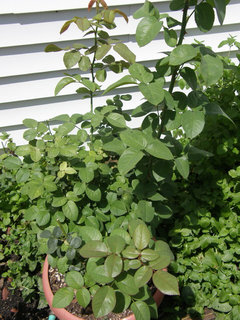 Vaporvac Z6-OhioRiverValley thanked strawchicago z5
Vaporvac Z6-OhioRiverValley thanked strawchicago z5Khalid Waleed (zone 9b Isb)
7 years agoFor the first time in many decades, I had zero black spot in around 130 rose bushes that I grow. Perhaps use of wood ash worked as it raised the soil pH quite a bit. It had it's own negative affects in other ways but it prevented black spot in my roses this season, I guess. Even in monsoon when the humidity generally stays over 70% all the time and temps are between 80 to 90 generally, there was no black spot this year whereas in previous years, my bushes used to get lot of it during monsoon.
Does a pH level around 7.5 to 8 help in controlling black spot in your areas?
mad_gallica (z5 Eastern NY)
7 years agoNo, high pH does nothing in respect to blackspot here. We have similar humidity, with nighttime temperatures squarely in the happy zone for blackspot. The only things that seem to work here are planting naturally highly resistant roses, and serious chemicals. I don't consider spraying sulfur three times a week to be a solution to anything, and that is the only other thing that might work.
Vaporvac Z6-OhioRiverValley thanked mad_gallica (z5 Eastern NY)Vaporvac Z6-OhioRiverValley
Original Author7 years agoStraw, would 1/5Tbls of Azomite be enough for an in-ground plant? Do you think it was the Azomite or the pea-gravel that helped? Did you add them both at the same time? Most of my roses are supposedly bred for BS resistance, I just think some of them need a little help this, their first year. I will say my three Kordes roses (Dark Desire, Summer romance and Fire Opal) have been rock solid resistant thus far, as well as Viking Queen.
Interesting, Khalid about the addition of wood-ash. Is that the only change you made this year?
Will a spray of soapy water help or is it just the Baking soda in the Cornell mix? What does the oil do?
strawchicago z5
7 years agoVaporvac: I'll answer your question in the thread "Azomite, which I'll bump up" soon. I like to organize all the info. in one place "Azomite" so when others google for that title, they'll see that.
Vaporvac Z6-OhioRiverValley thanked strawchicago z5Vaporvac Z6-OhioRiverValley
Original Author7 years agoThank you, straw! That is best and sort of what I was thinking for this post, but for BS. I know you've mentioned many prophylactic and remedial methods, but they're usually buried in a post on something else. Just be sure to put a link here. Then when people find this post, they'll find links to many approaches. No sense rewriting everything.
Khalid Waleed (zone 9b Isb)
7 years agoValrose wrote: "Interesting, Khalid about the addition of wood-ash. Is that the only change you made this year?
Valrose: I am not sure what exactly controlled black spot in my garden but this is the first time I had zero black spot in my roses. May be in the whole year I could detect a few old leaves getting black spot during recent monsoon rains. But nothing in spring when the roses in my area are quite vulnerable, there was no black spot at all. I have around 80 roses in pots and remaining in ground. If I correctly recall I did following...
- I didn't use any fungicides / pesticides and didn't use any synthetic fertilizers too. I fed my roses with home made compost (banana & other vegetable / fruit peels, egg shells, tea bags, guavas, added with chicken manure, wood ash etc).
- In spring I gave all my roses an application of gypsum.
- When it rained, I gave some wood ash to my roses on numerous occasions throughout the year. During spring I made a solution of wood ash and vinegar and mixed it in tap water while watering my plants.
- Occasional dozes of potash, 1 spoon in 15 liters of water.
- During winters, I topped up all pots and rose beds with as many leaves as I could (3-4 inches layer). I guess that doesn't help in controlling black spot but surprisingly there was no black spot.
- Less a few blooms that were taken for making rose tea or for bouquets, all blooms went back to the same pot or bed whole year and I make a deliberate effort to ensure this every morning.
- Occasional application of shake made of spinach, mint etc, diluted in water.
- Compost tea spray 4-5 times in the year and feeding diluted compost tea on numerous occasion.
- Trimming leaves at the base of a bush, making the bush sort of bald at the four inches from the soil level.
- Keept a reasonable distance amongst the bushes, allowing as much air circulation as possible. Didn't plant too many companion plants along side my roses and avoided over crowding of vegetation. The only companion plants that I grew in the rose beds were Lilium and Freesia in spring and Portulaca in summers, nothing else.
I guess this is what I did. I am not sure which one of the above or a combination of them worked but for the first time since I started growing roses, I had ZERO blackspot. High pH did result in locking of certain minerals and I had iron and copper deficiencies in my some of my roses but no black spot.
best regards.
Vaporvac Z6-OhioRiverValley thanked Khalid Waleed (zone 9b Isb)strawchicago z5
7 years agolast modified: 7 years agoAgree with Khalid: it's a balance of acid (rain at pH below 5, decayed leaves, mint, spinach, gypsum) with alkaline base (wood-ash), plus anti-fungal trace-elements in wood-ash, plus decent calcium & potassium for health, plus chicken manure with zinc, copper, boron as anti-fungal-agents.
The east coast rain is even more acidic, at pH around 4.5, compared to west coast rain of pH 5.6. I posted a pic. of U.S. map with pH rain values. Rain leaches out major nutrients (calcium, potassium plus trace elements) even with my fertile clay.
That's exactly what I did from 2011 to 2013 and posted many pics. of clean roses past frost dates. I used chicken manure & alfalfa for fast growth of leaves. Instead of wood-ash I used horse manure at pH over 8 (has shell lime & trace-elements). That's 4 applications in a rainy year to lock in moisture plus to provide constant release of anti-fungal trace elements, plus microbes to make the soil below fluffy.
I also have my dolomitic clay (high calcium & high magnesium & high potassium, pH 8), plus gypsum to break up clay.
Sure, my roses are pale with higher pH, but they bloom well despite a shady garden with less than 5 hours of sun. Health is balance: when one gets acid (rain or decayed organics), make sure that one has alkaline minerals such as wood-ash to neutralize the acid. I posted plenty on the anti-fungal trace elements in wood-ash.
When the acidic rain is not neutralized, it will make leaves thinner (more susceptible to fungal invasion), acid rain also leaches out calcium & potassium & magnesium & trace elements essential for blooming and health.
From one of the documents I researched, it stated that calcium & iron, boron, zinc, copper & most trace elements CANNOT BE APPLIED at once, it has to be slow-released as needed. Thus the logic for slow-released organics such as wood-ash and horse-manure.
People don't realize that as own-roots mature, they become woodier and secrete more acid. Marie Pavie used to like gypsum (17% sulfur, acidic), now in its 5th year I have to give it Azomite (pH 9).
I came back to the above regime on September 10, that's when husband helped me to get horse manure at pH over 8. Here's the result, Neil Diamond with very shiny leaves today, pic. taken Sep. 19:

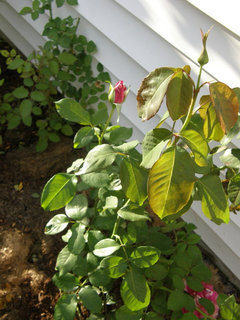
Radio times blooming in less than 4 hours of sun & healthy foliage, pic. taken Sep. 19 I posted the base of that bush in the other thread a few days ago:
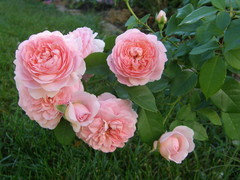
Vaporvac Z6-OhioRiverValley
Original Author7 years agoWell, almost all my roses now have some blackspot, some quite bad. Cornell formula did nothing, but probably applied too late. I may break down and try sulphur. :( However, one bright spot on my little Margo Koster in a pot. She was the first to exhibit bad symptoms after 6" of rain in one hour and more following! Following Straw's advice, I top-dressed with my native clay soil and lo and behold, she's totally clean. I planted her out two days ago and hope she stays that way next to BS Cecile Brunner. I'll have to dig some more clay to put over my other roses and see what happens. I have one more BS potted rose that I'll try first and report back.
strawchicago z5
7 years agolast modified: 7 years agoThank you, vaporvac, for your honest report. I have been doing that for the past 5 years: Induced blackspot via acidic & wet mulch, such as cocoa mulch at pH 5.6, then reversed it completely just by topping with my alkaline clay at pH near 8. I posted those pics. in 2013, that's for a disease-resistant Christopher Marlowe.
This year I did the same: I tested grass-clippings as mulch .. that was too acidic and Pat Austin broke out in blackspot. I scraped that off, and topped with horse manure at pH 8, plus chicken manure with anti-fungal agents .. new growth in upper half is 100% clean.
Vaporvac Z6-OhioRiverValley
Original Author7 years agolast modified: 7 years agoUpdate: MY MargoK started to BS again after planting her out next to BS Cecile Brunner. So I used the last of the yellow clay to top-dress and, voila!, BS gone. I also did the same to my Darcey Bussells: one already had it and the other next to it, started to catch it. I top-dressed the latter with yellow clay and it did not progress. I'll post a pic later. This is truly amazing.
After planting a red osier dogwood out front, I salvaged two bucketfuls of yellow clay and will apply it to my CBs and the other DB and see if I can help them, since they are the worst. My potted Tess has continued healthy since her "treatment" and is sending out alot of new growth. We have had consistent rain and suddenly cooler temps this past week.
Fellow OR people, do you think it's the clay itself or the fact that it provides a bs-free barrier on top of the soil, that is giving this marked result? I say bs-free because this clay comes from a much deeper level. My DBussell that's bad had its very high graft covered with just topsoil I had leftover after planting. It was from the bed with Cecile Brunner.
totoro z7b Md
7 years agoI am going to try this clay top dressing too. I have clay soil, but I amend my soil so much that there is not much in the planting hole.
How much do you use on top?
I am no expert, but my guess is that it is the nutrients in the clay. I believe Valrose said she never does local control of spores (picking up fallen diseased leaves) and focuses on good soil nutrition to prevent blackspot.
Vaporvac Z6-OhioRiverValley thanked totoro z7b MdVaporvac Z6-OhioRiverValley
Original Author7 years agoHere are some pics. The one in the pot is TessOTD'Urberville. If you enlarge, you can see how I applied it. I just tried to squish the clay to extend it, since I didn't have a lot.

The others are Darcy Bussell (one treated, the other not):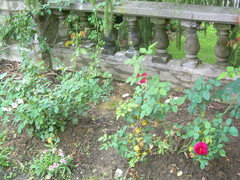
MargoKoster next to CB and Fire Opal.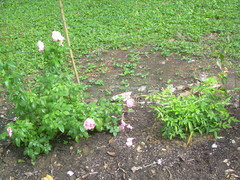
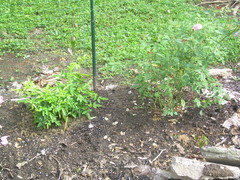
If this helps CBrunner I may dig around elsewhere in my garden for more. I am putting it on my Tooth Fairy tomorrow. Sorry my pics are so poor.strawchicago z5
7 years agolast modified: 7 years agoVaporvac: Thank you for posting fantastic pics. to show how nutrient-rich & alkaline clay can buffer against acidic rain. I really appreciate bush-shot pictures which show the shape of each rose.
I wish more folks would post entire-bush at a distance like you and Khalid, it really helps to know the shape of each rose. Your roses are healthy & vigorous young own-roots .. will definitely give a great spring flush.
totoro z7b Md
7 years agoRegarding the mechanism of how the clay works, I would be curious to what others think.
I have this one rose Cream Abundance that I bought before I knew anything about disease resistance that I used to clean up the fallen blackspot leaves. I got a ton of blackspot on this rose in late August and early September.
Shortly thereafter after I decided to improve the soil and fixing nutrient deficiencies, I stopped picking up the leaves (just to see what would happen) and the black spot stopped and the leaves started looking so much healthier and new leaves grew. So that is why I think that better nutrition trumps trying to suppress the spores in the soil. But the weather is also cooling, so who knows?
Vaporvac Z6-OhioRiverValley thanked totoro z7b Mdstrawchicago z5
7 years agolast modified: 7 years agoFor decades I NEVER pick up diseased leaves, be it rust, mildew, or blackspot. I just dump alkaline soil on top. Alkaline clay has plenty of beneficial bacteria that suppress the bad fungi.
Here's an abstract, a jointed effort between United Kingdom and Sweden. I posted the below abstract since 2011 in Rose forum, but Bayer-gang ridiculed me, despite their lack of posting pics., versus my tons of pics. as proof for the past 6 years.
Talk is cheap, pictures are what count, plus I date my pics.
Decrease in soil pH via acidic rain means more bad fungi (blackspot, mildew, rust), LESS beneficial soil bacteria to fix nitrogen, and LESS nitrogen due to leaching. The horse manure I get has pH over 8, same with my bottom-hard-clay.: http://aem.asm.org/content/75/6/1589
Contrasting Soil pH Effects on Fungal and Bacterial Growth ABSTRACT
"The influence of pH on the two principal decomposer groups in soil, fungi and bacteria, was investigated along a continuous soil pH gradient at Hoosfield acid strip at Rothamsted Research in the United Kingdom. This experimental location provides a uniform pH gradient, ranging from pH 8.3 to 4.0, within 180 m in a silty loam soil.The growth-based measurements revealed a fivefold decrease in bacterial growth and a fivefold increase in fungal growth with lower pH. .. Below pH 4.5 there was universal inhibition of all microbial variables. "
totoro z7b Md
7 years agoMaybe I will just put lime on the ground before a big rain. My soil is acidic.
Thus is a dumb question but doesn't all the additional soul raise the soil level over time or does it just keep sinking down?
strawchicago z5
7 years agolast modified: 7 years agoTotoro (Aileen); A physician like you always ask good questions. Yes, fall is a good time for liming (recommended by many University Extensions, such as U. of Vermont). I no longer use lime, since alkaline clay is better ... I always put tons of clay pre-winter.
I see soil sinking down in loamy pots, so that does used up by plants. The exception is heavy clay: both acidic clay in my last house, and alkaline clay in my house, don't sink down much, except through a wet winter, when roots are "heaved" upward.
Val is right about planting own-roots a few inches above ground level in warmer zone. For my cold zone 5a, I plant own-roots at ground level, since it'll sink down, plus I pile up more clay on top.
Vaporvac Z6-OhioRiverValley
Original Author7 years agoTotora, I have the same questions. The clay has definitely helped the BS on those three buses. I applied it yesterday to the other small ORs, so we'll see what happens. It is hard to know because the BS seems to have stopped progressing naturally due to cooler weather. However, I did the original clay experiment when it was raining continually and in the 90s. It's going to be in the 80s again this week, so we'll see what happens. The real test will be NEXT Fall as I'll continue to apply. Anyone have thoughts on how often to apply it?
I should note that the leaves of the Darcey Bussell with BS also show signs of chlorosis. I'll try to take a pic today and edit this post. I wonder how that ties in. Its neighboring DB is healthy with clay topping.
strawchicago z5
7 years agolast modified: 7 years agoI'm organizing the info. for future reference *****
Yes to black-peat humus as topping to buffer acidic rain, plus NPK of at least 10-10-10 for pots. Tested black-peat-humus plus horse manure (both alkaline) in 2011 for roses in the ground (clean past Nov), plus black-peat-humus potting soil (mixed with alkaline sand) for roses in pot in 2015 (Perle and Cloudert Soupert, both healthy until snow). Humus can hold the equivalent of 80–90% of its weight in moisture, and therefore increases the soil's capacity to withstand drought conditions.[32][33]The biochemical structure of humus enables it to moderate – or buffer – excessive acid or alkaline soil conditions.[34]https://en.wikipedia.org/wiki/Humus
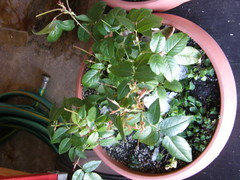
Above pic. is Perle d' Or, own-root in a pot with snow, winterized in my dark & unheated garage. Pic. taken the day before Thanksgiving, Nov. 25, 2015. It's 100% healthy, no pests, no diseases. Things I did right this year:
- Own-root from a tiny-rooting is wimpy & small. So put a 4" layer of soil mixed with alfalfa pellets ON TOP. That for constant release of nutrients, plus to lock in moisture.
- This was wet year. To buffer acidic rain, I put 1/4 cup of pea-gravel, for slow-release of calcium & magnesium & trace elements. Advantages: Pea gravel magnifies the fragrance. Pea-gravel scatters out and doesn't block out rain like big-chunk red-lava rock. Pea gravel is alkaline, so it neutralizes acidic rain.
- It rained so much I didn't bother with SOLUBLE fertilizer. I followed U. of Kentucky success with Omega 6-6-6 (blood meal, bone meal, sulfate of potash). I put high-bone meal fertilizer NPK 4-10-7 in the potting mix. Also topped with 1/2 tablespoon sulfate of potash, 1 tablespoon gypsum, and 2 tablespoon blood meal. This lasted for 2 weeks of constant rain.
Vaporvac Z6-OhioRiverValley thanked strawchicago z5strawchicago z5
3 years agoBump this up since I like Vaporvac's successful experiment by topping with yellow clay (rich in calcium) to offset the acidity of rain that THIN OUT roses' leaves & more susceptible to black spots.
strawchicago z5
3 years agoForget to mention that GYPSUM IS ACIDIC, best used to speed up drainage pots MONTHS BEFORE PLANTING. Lime is alkaline and neutralizes acidic rain with lime's pH over 12. Dolomitic lime (has both calcium and magnesium) is even better to buffer the acidity of rain. Walmart sells Epsoma Garden lime which is dolomtic.
Vaporvac Z6-OhioRiverValley thanked strawchicago z5
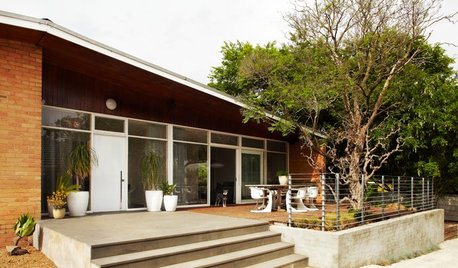
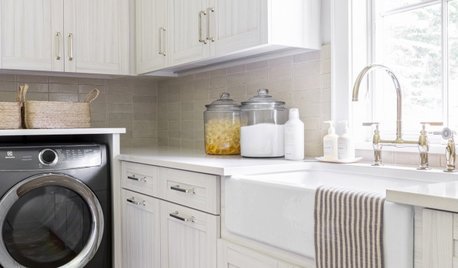
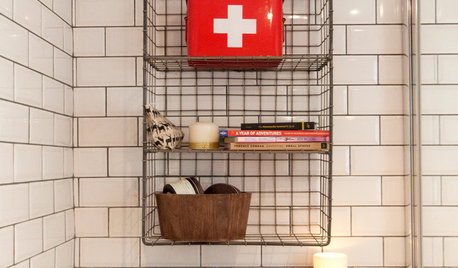



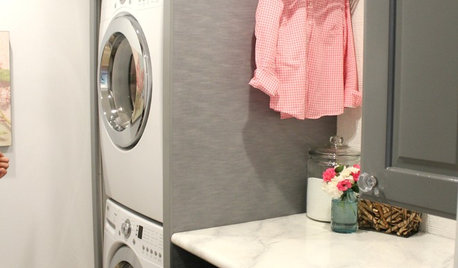
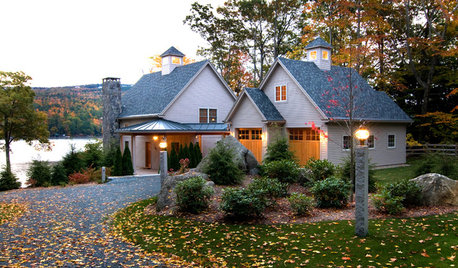

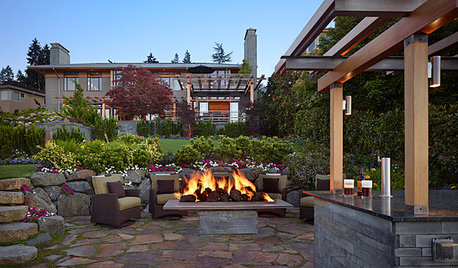






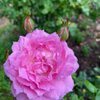
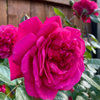
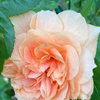
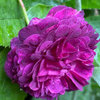
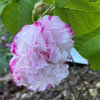
ValRose PNW Wa 8a